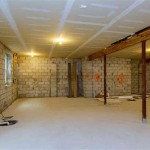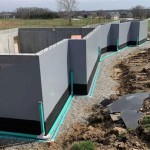Retaining Wall Walkout Basement Landscaping Ideas
Landscaping around a walkout basement presents unique challenges and opportunities. The presence of a retaining wall, often necessary to support the raised grade, introduces both structural and aesthetic considerations. Planning landscaping for a walkout basement with a retaining wall necessitates a comprehensive approach that addresses drainage, stability, and the creation of a visually appealing and functional outdoor space.
The primary aim is to seamlessly integrate the retaining wall into the overall landscape design, transforming it from a purely functional element into an attractive feature. This integration involves careful selection of materials, plant choices, and hardscaping elements that complement the architectural style of the house and the surrounding environment. Thoughtful planning will allow for the creation of a harmonious transition between the indoor and outdoor living spaces, maximizing the utility and enjoyment of the walkout basement area.
Before embarking on any landscaping project, a thorough assessment of the existing conditions is crucial. This assessment should include evaluating the soil type, drainage patterns, sun exposure, and the structural integrity of the retaining wall itself. Addressing any existing drainage issues is paramount to prevent water damage to the foundation and the retaining wall. Poor drainage can lead to hydrostatic pressure, soil erosion, and potential structural failure of the wall.
Furthermore, understanding the local climate and microclimate conditions will inform plant selection. Choosing plants that are well-suited to the specific growing conditions will ensure their long-term health and vigor, reducing the need for excessive maintenance and replacement. Careful consideration should also be given to the mature size of plants to avoid overcrowding and potential damage to the retaining wall.
Planning for Proper Drainage
Effective drainage is paramount when landscaping around a walkout basement with a retaining wall. The goal is to divert water away from the foundation and prevent it from accumulating behind the wall, which can lead to hydrostatic pressure. Several drainage solutions can be implemented, either individually or in combination, to achieve optimal water management.
One common method is the installation of a French drain behind the retaining wall. A French drain typically consists of a perforated pipe surrounded by gravel, which allows water to flow freely away from the wall. The pipe is usually sloped slightly to ensure efficient drainage and is connected to a discharge point, such as a storm sewer or a dry well. The gravel acts as a filter, preventing soil particles from clogging the pipe.
Surface drainage is equally important. Grading the soil away from the foundation and retaining wall will encourage water to flow away from these structures. Swales, or shallow depressions, can be incorporated into the landscape design to channel surface runoff to appropriate drainage outlets. Permeable paving materials, such as gravel, pavers, or porous concrete, can also be used to reduce surface runoff and allow water to infiltrate into the ground.
Downspouts from the roof should be extended away from the foundation to prevent water from pooling near the basement walls. Underground drainage pipes can be used to carry water from the downspouts to a designated discharge area. It is also prudent to install gutters and downspouts that are properly sized to handle the expected rainfall volume in the region.
Another important consideration is the type of soil used for backfilling behind the retaining wall. Using well-draining soil, such as a sandy loam, will help to facilitate water movement and prevent waterlogging. Compacted soil can impede drainage and increase the risk of hydrostatic pressure. Adding organic matter to the soil can improve its drainage characteristics and provide essential nutrients for plant growth.
Selecting Appropriate Plants
Choosing the right plants is essential for creating a visually appealing and sustainable landscape around a walkout basement and retaining wall. The plant selection should be based on several factors, including the amount of sunlight the area receives, the soil type, the climate, and the desired aesthetic. It is also important to consider the mature size of the plants to avoid overcrowding and potential damage to the retaining wall.
Groundcover plants are an excellent choice for slopes and areas adjacent to retaining walls. They help to stabilize the soil, prevent erosion, and add visual interest to the landscape. Some popular groundcover options include creeping thyme, sedum, and vinca minor. These plants are typically low-maintenance and drought-tolerant, making them ideal for challenging growing conditions.
Shrubs can be used to soften the harsh lines of the retaining wall and provide vertical interest to the landscape. Evergreen shrubs, such as boxwood, yew, and juniper, can provide year-round greenery and create a sense of privacy. Deciduous shrubs, such as hydrangea, lilac, and spirea, offer seasonal color and texture. When selecting shrubs, it is important to choose varieties that are appropriate for the size of the space and the amount of sunlight available.
Trees can be incorporated into the landscape to provide shade, create a focal point, and enhance the overall aesthetic. However, it is important to choose trees that are not too large or aggressive, as their roots can potentially damage the retaining wall. Smaller trees, such as Japanese maples, dogwoods, and crabapples, are often good choices for smaller spaces. Fastigiate or columnar trees can also be used to provide vertical interest without taking up too much horizontal space.
When planting near the retaining wall, it is important to avoid planting trees or shrubs with aggressive root systems that could potentially damage the structure. Instead, focus on plants with shallow, fibrous root systems that will help to stabilize the soil without posing a threat to the wall. It is also a good idea to create a planting bed at the base of the wall to prevent soil from directly contacting the structure. The planting bed should be well-drained and amended with organic matter to provide optimal growing conditions for the plants.
Consider incorporating native plants into the landscape. Native plants are well-adapted to the local climate and soil conditions, making them more resilient and requiring less maintenance. They also provide valuable habitat for native wildlife, such as birds and butterflies. Local nurseries and extension offices can provide information on the best native plants for the region.
Integrating Hardscaping Elements
Hardscaping elements, such as patios, walkways, and steps, can significantly enhance the functionality and aesthetics of a walkout basement landscape. These elements provide access to different areas of the yard, create outdoor living spaces, and add visual interest to the landscape. Careful planning and design are essential to ensure that the hardscaping elements are seamlessly integrated with the retaining wall and the overall landscape.
Patios can be created at the base of the retaining wall to provide an outdoor living space for relaxing, entertaining, and dining. The patio can be constructed from a variety of materials, such as concrete, pavers, stone, or wood. The choice of material should be based on the desired aesthetic, the budget, and the durability requirements. Consider adding features such as outdoor kitchens, fireplaces, or seating areas to enhance the functionality of the patio.
Walkways can be used to connect different areas of the yard and provide access to the walkout basement entrance. Walkways can be constructed from a variety of materials, such as gravel, pavers, stone, or concrete. The walkway should be wide enough to accommodate foot traffic and should have a smooth, even surface to prevent tripping hazards. Consider adding lighting along the walkway to improve safety and visibility at night.
Steps are essential for providing access to different levels of the landscape, especially when there is a significant elevation change between the walkout basement and the upper yard. Steps can be constructed from a variety of materials, such as stone, wood, or concrete. The steps should be properly sized and spaced to ensure a comfortable and safe ascent and descent. Handrails should be installed on steps that are more than a few feet high.
Retaining walls themselves can be aesthetically enhanced through the use of different materials and textures. Natural stone, such as limestone or sandstone, can create a rustic and natural look. Concrete blocks can be used to create a more modern and contemporary look. The wall can also be textured or stained to add visual interest. Consider incorporating decorative elements, such as lighting, planters, or water features, into the retaining wall design.
Additionally, consider incorporating landscape lighting to highlight the retaining wall, plants, and hardscaping elements. Lighting can create a dramatic effect at night and improve safety and security. Path lighting can be used to illuminate walkways and steps, while uplighting can be used to highlight trees and shrubs. Spotlights can be used to accent the retaining wall and other architectural features.
The selection of materials and design should complement the style of the house and the surrounding landscape. Creating a cohesive and harmonious design will ensure that the walkout basement landscape is both functional and aesthetically pleasing.

Walkout Basement Design Ideas Landscape Management Group

Walkout Basement Landscaping Ideas To Transform Your Home

Pin By Barbara Williams On Cabin Renovation Sloped Backyard Landscaping Retaining Walls

Walk Out Basement Retaining Wall Ideas

Challenges Integrating A Walkout Basement Into Sloped Property General Q Chieftalk Forum

Retainer Wall Build And Planting A Dry Creek Bed Creative Cain Cabin
Walkout Basement Patio And Landscape Ideas Photo Gallery By Jennifer Harvey At Pbase Com

Walkout Basement Landscaping Ideas Photos Houzz

Pin By Stephanie Masters On Back Yard Front Patio Concrete Backyard
Walkout Basement Patio And Landscape Ideas Photo Gallery By Jennifer Harvey At Pbase Com
Related Posts







